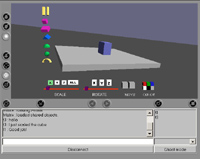|
Independent Study Proposal: Architectural Design
CVE
Thomas Vollaro
- School of Information MSI
The proposed application is a virtual environment for multi-user design
collaboration and instruction. The environment will allow multiple
designers, represented by their avatars, to collaborate on spatial design
problems. The GUI would be similar to popular 3D CAD applications,
but the users would be able to experience and manipulate the space in
full-scale. Users will also be able to collaborate on the proposed
design via chat or voice support. The intent of this project is to explore
the possibilities of applying Collaborative Virtual Environments (CVE)
to the architectural design domain. The implementation will be a simple,
web-based application based on a hypothetical usage scenario. User tests
will be conducted to highlight usability problems. The results will
be made available for any future work.
Key features
- GUI for creating and manipulating virtual “study
models”. A library of standard architectural forms will be provided
as well as tools for exploring non-standard geometries and generative
designs.
- Multi-user chat or voice sharing for commenting
on design proposals, instructing students, or giving "tours" to clients.
- The ability to save work using a standard 3D
file format (VRML or 3DS).
Potential Usage Scenarios
- Architects, engineers, and designers can create,
manipulate, and study simple design concepts (study models) in an
immersive, multi-user environment. Two architects working in separate
locations can access the same model to discuss conceptual design options.
- Educators can present historic architectural
spaces and design objects in full scale. Students can explore
the spaces and manipulate and re-configure design elements.
- Construction professionals on-site can view
and discuss details with architects back in the office.
Implementation
- Phase 1: Conduct a literature search and competive
analysis of exisiting CVE's and single-user 3D tools (in
progress).
- Phase 2: Construct a hypothetical use-case based
on one of the scenarios listed above. Develop a simplfied VRML world,
GUI, primitive library, manipulation tools, and viewing tools in VRML.
- Phase 3: Port environment to an existing multi-user
VRML platform to develop and test collaborative features [See links
below].
- Phase 4: Conduct user-tests with architecture
students and educators to determine the usability of of the system.
I will establish a set of usability metrics with a focus on multi-user
collaboration (e.g. avatar awareness, coordinating tasks, communication
using chat features).
Relevant Literature and Web Links
- Deep Matrix [a multi-user
VRML server implemented in Java]
- VNet
[a multi-user VRML server implemented in Java]
copyright © Thomas Vollaro 2002
|


